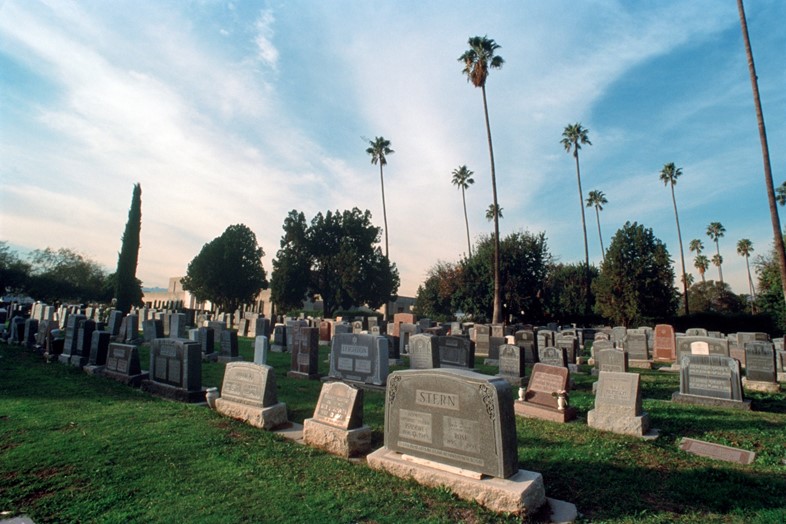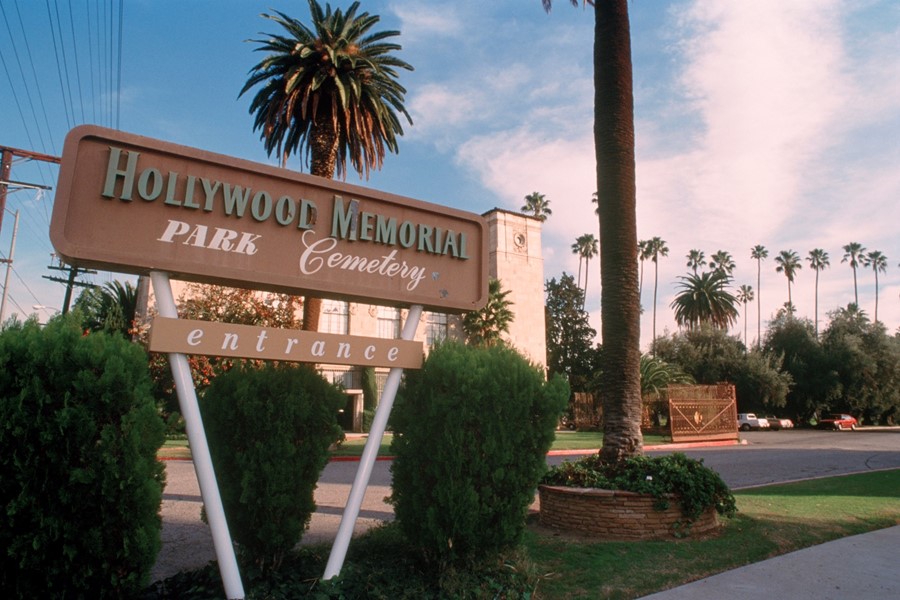The final resting place of a slew of stars – from Judy Garland to Johnny Ramone – the Hollywood Forever cemetery became an unlikely inspiration for Alessandro Michele at Gucci
It’s easy to forget that Los Angeles isn’t just endless sunshine, hillside mansions and palm-lined beaches. With its teeming criminal underbelly, many of Hollywood’s greatest hits – from Billy Wilder’s Sunset Boulevard to David Lynch’s Mulholland Drive – are exercises in self-reflection, turning their lens back on their own city to probe the horror that bubbles beneath the surface. When you really stop to think about the chequered history of California’s largest urban sprawl, the most memorable events aren’t glamorous tales of old Hollywood, but the grisly crimes of the Black Dahlia murder, the Manson Family’s homicidal rampages, or even the South Central L.A. gang wars.
It makes sense, then, that one of the city’s most popular tourist attractions is also its most macabre. The Hollywood Forever Cemetery, founded in 1899, has always been inexorably tied to the rise of the film industry: the iconic centre of Hollywood’s Golden Age, Paramount Pictures, was established on the same plot of land. Appropriately, given the scandalous stories behind many of its interred celebrities, the cemetery spent almost six decades defined by the misdemeanours of its long-time owner, Jules Roth, who embezzled millions from the cemetery and let it fall into disrepair.
Upon Roth’s death in 1998, Hollywood Forever was purchased and given a new lease of life by a pair of equally corrupt owners, the Cassity brothers; thankfully, however, their criminal interests lay elsewhere, and they lavished money on restoring the cemetery to its former glories. Now as much a theme park as it is a final resting place, you’re more likely to see tour groups flashing cameras than the mourning family and friends of the dead. Entering via the grand driveway on Santa Monica Boulevard, the car park is packed with those coming to pay their respects at the graves of Golden Age luminaries like Judy Garland, Rudy Valentino, Jayne Mansfield and Cecil B. DeMille – there’s even a gift shop for the morbid souvenir hunter.
No filmmaker has chronicled Los Angeles’ sinister underbelly more obsessively than Kenneth Anger, so his fascination with the cemetery doesn’t exactly come as a surprise. His shadow looms so large over the place that long-time tour guide Karie Bible (yes, that’s her real name) notes that people often challenge her with alternative stories about the figures buried there. Where did they read them? In Anger’s brilliant, gossipy collection of the Golden Age’s most salacious stories, Hollywood Babylon, a kind of silent era TMZ described upon its publication by the New York Times as “a delicious 306‐page box of poisoned bonbons”.

While the book veers between fact and fiction, it’s a rip-roaring ride through the mad, bad and dangerous behaviour of tinseltown’s most celebrated figures, many of whom ended up interred at Hollywood Forever. Anecdotes include Jimmy Dean cruising for anonymous sex in bondage bars with men and women, earning the nickname “the human ashtray” for his kink of asking others to stub out their cigarettes on his chest, while Jayne Mansfield’s death by car crash is described in lurid detail, from her alleged decapitation, to the rumours she was assassinated for her links to the Church of Satan.
A particularly juicy (if widely discredited) story involved Rudy Valentino and his silent era rival, the closeted Ramón Novarro. Following a night of passion, Valentino had gifted Novarro an Art Deco dildo cast from his own penis, and when Novarro was murdered in 1968, rumours ricocheted around Hollywood that the dildo had been used as the offending weapon and was found stuffed in Novarro’s mouth. There’s a perverse pleasure in flicking through Anger’s voyeuristic window into a lost world, even if his flippant approach to this catalogue of death and misery is at times a little chilling.
More recently, the fashion industry has developed a newfound interest in Hollywood’s darker side – partly thanks to Gucci’s creative director Alessandro Michele. His latest collection referenced the city’s most debauched hotspot, Chateau Marmont, and his S/S17 collection featured jackets emblazoned with ‘Hollywood Forever’ on the reverse, inspired by a visit he paid to the cemetery with Linda Ramone (wife of Johnny, who is also buried there).
While this seems surprising – you might associate Michele’s designs with a spirit of florid, European bohemianism, and not the seedy horror of Los Angeles noir – in recent seasons he’s slowly turned the dial towards a darker and more dangerous attitude. Take his Cruise 2019 collection, which saw models traipse through an ancient burial ground, illuminated by the sinister glow of flaming torches, or the mutant bodies of his clinical, future-forward A/W18 show.
Plus, as a secular cemetery where many of those interred were more than partial to a bit of bling, Hollywood Forever plays host to many ostentatious burial sites that would surely appeal to Michele’s maximalist instincts. There’s a peacock aviary tucked in a far corner, a Roman-style mausoleum replete with oversized replicas of classical sculpture, and even a marble-lined pavilion dedicated to Judy Garland, which might just deserve the title of the campiest place on earth – perfect for a designer whose most recent collaboration was with king of kitsch Elton John.
These days at Hollywood Forever, you might still see a 91-year-old Anger strolling around on a sunny afternoon, or a celebrity surreptitiously sneaking past the tourists to pay their respects to a relative; when I visited last month, I was told by a fellow visitor that I had just missed Anjelica Huston visiting the grave of her famous father. Thanks to morbid gossipmongers like Anger and reverent admirers like Michele, the legacy of those buried here continues to be revived and introduced to younger generations. In Los Angeles – where high glamour and violent crime are still bedfellows – it’s a reminder that matinée idols might come and go, but a true star lasts forever.
